Content
- 1 The best varieties of red early raspberries
- 2 What are the most productive varieties of late raspberries
- 3 The best new varieties of large-fruited remontant raspberries
- 4 What are the varieties of yellow raspberries
- 5 The best remontant varieties of raspberries
- 6 The best classic raspberries
- 7 The best standard raspberry varieties
- 8 The best early raspberries
- 9 Malina News Kuzmina
- 10 Raspberry Meteor
- 11 Raspberry Runaway
- 12 Raspberry Scarlet Sails
- 13 Raspberry Lyashka (Laszka, Lashka, Lyachka)
- 14 Raspberry Patricia
- 15 Raspberry Sun
- 16 Early raspberry varieties
- 17 Mid-season varieties
- 18 Late ripening varieties
- 19 Repaired plants
- 20 Yellow raspberry
- 21 Black varieties
Among them, gardeners can choose the best to their taste: early or late, high-yielding or remontant, with berries of red, yellow and even black. Find out which raspberry varieties are most popular in hobby gardening.
The best varieties of red early raspberries
"Balm". Slightly spreading bush, medium height, medium shoot-forming ability. The berries of this early raspberry variety are conical, dark raspberry with slight pubescence, sweet and sour taste with aroma.
"Modest". The bush is medium, slightly spreading. Berries are hemispherical, dark raspberry color, sweet and sour taste, no aroma.
"Companion". The bush is erect, high. The berries of this are one of the earliest varieties of hemispherical raspberries, dark raspberry color, sweet and sour taste.
"Crane". Variety of medium early ripening, remontant. Slightly spreading bush, erect, powerful shoots. Berries are large, conical, raspberry, sweet and sour taste with aroma.
"Hussar". The bush is tall, powerful, does not need support, there is little overgrowth. This is one of the best early raspberries with elongated ruby red berries, sweet and sour taste and amazing aroma.
"Sun". The berries are large, round-conical, crimson in color with delicate fragrant pulp.
"Patricia" - the most interesting among large-fruited raspberry varieties with attractive, beautiful berries. The berries are large, individual up to 14 g, truncated-conical in shape, with a beautiful velvety surface, of medium density, they are removed from the fruit plant without breaking, when fully ripe they do not crumble for a long time. The taste of berries is sweet with a pleasant "raspberry" aroma, juicy melting pulp and a few small seeds. Productivity of 4-5 kg per bush. Fruiting annually, early ripening variety. One of the most productive varieties. Plants are medium-sized (up to 1.8 m), non-repaired, semi-sprawling, annually form 6-10 replacement shoots and 5-7 root suckers.
"Maroseyka" - the first domestic thornless variety with very large berries (up to 12 g) and high yield (4-5 kg per bush). Some of the red berries of this raspberry variety are double, conical. The taste of berries is sweet with a pleasant aroma. Fruiting annually, medium-early ripening variety. Bushes about 1.5 m tall, spreading, powerfully developed, not repaired.
"Aboriginal" - an early variety for areas of the non-chernozem zone. Differs in a high yield, large (4-8 g) bright red berries. The berries are conical, well-formed, easily removed from the fruit-bearing.
What are the most productive varieties of late raspberries
Below it is described which varieties of late raspberries are the most productive, and therefore are the most popular.
"Brigantine". Berries are dark raspberry, dense, round-conical, good taste.
"Tarusa" - the first domestic variety with standard-type shoots, strongly thickened, hard and tough.Bushes practically do not require supports, but still the harvest is better obtained with a trellis. The berries of this fruitful variety of raspberries are large (up to 12 g), blunt-conical, bright red in color, shiny, well removed from the fruit-bearing. The taste of berries is sweet with a pleasant raspberry aroma. Productivity of 3-4 kg per bush. The bushes of this variety are of medium height (about 1.5 m), compressed type, powerfully developed, non-repairable, form 8-10 replacement shoots and 4-5 root suckers each, do not creep over the site.
"Arbat" - among the new large-fruited varieties of raspberries, it stands out for the abundance of very large berries with a mass of 15-18 g and more. The berries are elongated and conical, dark red in color, shiny, removed from the fruit plant without breaking. The taste of berries is sweet with a pleasant raspberry aroma, juicy melting pulp. Productivity - up to 9 kg per bush. Plants of this one of the most productive varieties of raspberries are medium-sized (1.5-2, Ohm in height), spreading, powerfully developed, non-repairable.
"Hercules". This variety of raspberries has a medium-sized and slightly spreading bush, shoots are strong, upright, you can do without trellises when growing. Annual shoots are green in spring, and by autumn they acquire a purple hue with a waxy bloom. The thorns are hard, thin and prickly. Autumn harvest in the middle lane reaches 1.5 kg per bush. The first fruits appear on the bushes in early August. Fruiting lasts until the first frost. The fruits of this variety are very large, the average weight of one berry is 5 g, the maximum reaches 10 g. The berries have a truncated-conical shape. The color of the berry is ruby, the taste is sweet and sour.
"Daughter of Hercules". A high-yielding variety with very large tasty berries, weighing 8-10 g. Individual berries reach a weight of 20 g.
As you can see in the photo, this stock of raspberries has berries of an elongated blunt-conical shape, dense, well transportable:
The bush is medium-sized, the shoots are highly branched. Requires little support.
"Firebird". Large-fruited, high-yielding variety with bright red berries. A distinctive feature is high drought resistance and heat resistance.
"Calendar". This variety is sometimes called the "raspberry tree" for its powerful shoots and bush in general. Do not creep over the site. Recommended for growing in all horticultural zones of the European part of Russia.
"Beauty of Russia". It bears fruit with a very tasty berry and has an early ripening period. Berry weighing up to 12 g. This one of the best varieties of raspberries has a smooth trunk and bears fruit well in a sunny area, does not like thickening. Highly productive with good care. These berries not only can be eaten from the bush, they can be admired.
"Stolichnaya" - a late variety of raspberries, high-yielding, distinguished by powerful shoots without thorns. The berries are large (4-8 g), homogeneous, well removed from the fruit plant. When ripe, 3-4 days do not crumble.
The best new varieties of large-fruited remontant raspberries
Here you can find photos and descriptions of remontant type raspberry varieties.
"Indian summer". The first domestic cultivar of remontant raspberry with predominant fruiting on annual shoots.
"Apricot". Amber fruits with a pink blush have an apricot flavor. Such amazing berries delight not only children, but also seasoned adults. This raspberry begins to ripen in August and bears fruit until frost. During the summer-autumn period of fruiting, gardeners manage to collect up to 4 kg of berries. Semi-spreading bushes, medium height. Thorns are located mainly in the lower part of the shoots, so they do not interfere with caring for the plant and harvesting at all.
"Bryansk Marvel". The variety of this raspberry has a medium-sized and compact bush, which reaches a height of 1.6 m. Fruiting is abundant, fruits are large, up to 6 g. The berries have a graceful elongated-conical shape with a pleasant taste and delicate aroma. They separate well from the stalk. Up to 5 kg of raspberries are harvested from the bush. The first crop is harvested in July, and the second - from mid-August until the first frost.
"Taganka" - early variety, high-yielding, large-fruited. Numerous thorns on the shoots. The berries are large (4-8 g), conical. The grade is remontant. The berries of the autumn harvest are also very large (up to 6 g).
"Kalashnik" - a remontant variety, which is used exclusively for obtaining an autumn harvest.
"Pride of Russia". This one of the best varieties of remontant raspberry is distinguished by its large and attractive berries. Weight reaches 12 g, individual berries can reach 18 g. Fruits have a conical and blunt-conical shape with a velvety surface. The berries are easily removed from the stalk and, when fully ripe, do not crumble.
The taste is sweet, light and pleasant aroma. The berries are juicy and have small seeds. Up to 5 kg of fruits are harvested from each bush. Bears fruit every year. The variety ripens on July 8-10, therefore it is considered medium early. The bush of this variety is medium-sized and compact. The variety is not remontant.
"Cap of Monomakh". The variety is remontant, has a low bush in the form of a small tree, which forms several slightly drooping, highly branched shoots. The variety is distinguished by large fruits (up to 7 g) of ruby color, elongated blunt-conical shape. The berries come off well from the stalk, ripen in mid-August and bear fruit for a long time. You can collect 5.5 kg of berries from a bush. However, before the first frost, not all berries have time to ripen. The first crop is harvested in July, the second from mid-August until the first frost.
"Giant" considered one of the best varieties for cultivation in summer cottages. This is a new variety of raspberries that has a distinctive feature: it lacks thorns. The weight of the fruits of this one of the best varieties of large-fruited raspberries can be 25 g. The yield of one bush reaches 12 kg, of course, subject to all the rules of agricultural technology.
Atlant - one of the best varieties of remontant raspberries with very tasty and aromatic berries. Moreover, even cold and rainy weather does not negatively affect the taste of the berries. The first berries ripen in mid-August, and then the yield goes very quickly. By mid-September, up to 5 kg of fruit can be harvested from one bush with good care.
"August miracle" - remontant raspberry variety forms a low compact bush, consisting of 7-8 upright shoots. The berries are formed almost along the entire length of the shoot, large, weighing up to 4 g, excellent taste with a delicate aroma. High productivity - 4 kg per bush.
"Penguin". The variety got its name for the standard type of bush. Strong shoots with shortened internodes, does not require additional support (bush height 1.1-1.4 m). The variety is remontant, fruitful, one of the earliest ripening, until mid-September the harvest has time to ripen completely. The berries are large, 6-8 g, round-conical, dark crimson. After ripening, they can hang on the bush for 5-6 days without decaying.
"Eurasia". A variety with a ripening period in the first decade of August. Large berries with good taste. Raspberry-like fruiting of medium vigor.
What are the varieties of yellow raspberries
"Orange miracle". This remontant variety has large berries (10-12 g) of golden yellow color and elongated conical shape. The bush reaches a height of 1.6 meters. The thorns are soft and short. The bush of this yellow raspberry variety does not require support. The variety is high-yielding, which is usually not characteristic of yellow-fruited varieties.
"Golden autumn". Large-fruited, remontant variety with bright golden yellow berries. The berries are large, 5-7 g, individual up to 11 g, beautiful, elongated-conical, dense. Dessert-flavored berries with a persistent raspberry aroma. The yield is high. Resistant to diseases and pests.
"Yellow Miracle". Exceptionally productive remont variety, with large (6-8 g) yellow berries, Good dessert taste. The variety is vigorous, the shoots are thick and strong, but requires support.Differs in late onset of autumn fruiting (first decade of September). It is best used as a variety combining summer and autumn harvests.
"Yellow giant" considered the largest among all raspberry varieties. The sweet fruits reach the size of a walnut. The bushes grow crowded, up to 2.5 m in height. In the fall, the upper part of each shoot is cut off at a two-meter height. With this technique, you can achieve the formation of larger fruits. Shoots are strengthened on a trellis.
Now watch the video "Raspberry Varieties" to get a better idea of what shrubs and berries look like:
Review of the best varieties of the sweetest raspberries according to gardeners' reviews
Raspberries are a popular and healthy summer berry. Old adapted varieties in Central Russia are distinguished by their unpretentiousness and vitality. On the site, raspberries can even behave aggressively, capturing new territories and expanding the boundaries of the raspberry. This behavior is associated with the characteristics of the varieties and lack of care. The best varieties of raspberries according to reviews of gardeners from different regions are presented in our rating.
Raspberry varieties are conventionally divided into 4 groups: large-fruited, classic, renovation and standard (tree-like).
Large-fruited raspberry inherited from the parental forms a high mass of berries and low winter hardiness. When growing large-fruited varieties of raspberries in the Middle Lane, the shoots are bent down and covered for the winter. To obtain large berries, you will need to create the appropriate conditions: the introduction of organic matter, feeding, prevention of diseases and pests, regular watering. On poor soils, you cannot get a good harvest, and in a drought, the berries will simply dry out on the branches. The brightest representative of the group, which has many fans and is grown even in the Urals - Krasa Rossii.
Stock raspberrydespite the growing interest in the group, it remains exotic in Russian gardens. These varieties of raspberries are decorative, easy to pick berries, disease resistance and high yield (due to active lateral branching). "Raspberry tree" does not need support, the crown retains its shape under the weight of the berries. At the same time, the varieties show good frost resistance and unpretentious care. Formation consists in pinching the tops of the shoots by 10 - 15 cm. In this group, the Tarusa variety is distinguished.
Classic raspberry varieties bear fruit on the shoots of last year, so the ripening of berries begins early: from the end of June to July. Bushes overwinter with long shoots, which are recommended to be covered in the conditions of the Moscow region.
Repair raspberry bears fruit on both last year's and young shoots. But experienced gardeners recommend cutting out all the shoots in the winter and getting one late harvest on a young growth. In this case, the yield will be higher and the size of the berries will be larger. Fruiting period for remontant varieties: from late July to September-October. Many varieties of remontant raspberries are well suited for the Moscow region. Their advantages: they winter without problems, do not suffer from pests, and are superior in yield.
The choice of the best raspberry variety also depends on the purpose of the raspberry planting: for home use of dessert berries or for the sale of a marketable crop. Commercial varieties are distinguished by high yields, transportability and attractiveness of berries, but inferior in taste.
The best varieties of raspberries according to gardeners' reviews
The best remontant varieties of raspberries
|
Polka 250 (for one year old seedling in a bag with wet moss) A remontant dessert variety of Polish selection. Sprawling bush, 1.6 - 1.8 m high, forms little root growth, gives up to 10 replacement shoots. Shoots are strong, do not bend during fruiting, covered with small, thornless thorns. The berries are dark red, rounded-oblong, with an average weight of 5-6 g, sweet taste, with a pronounced bright aroma, well stored and transported. The yield of one bush, with proper care, exceeds 4 kg.Berries do not crumble, are transported, due to dry separation, they are ideal in freezing. Shows high resistance to gray rot and spider mites, but susceptible to cancer of the measles system. It has low winter hardiness, but with complete mowing of shoots, this disadvantage is not of paramount importance. In arid climates, it behaves badly. This remontant variety of raspberries received good reviews from gardeners in the Rostov region and the Moscow region. Main pluses:
Minuses:
|
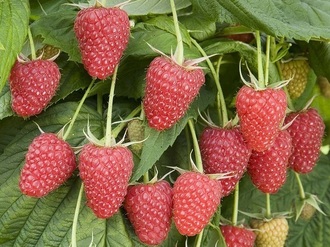 9.8 / 10 Rating Reviews The most delicious remontant berry. In regions with harsh winters, it is best to cut flush with the ground and mulch well.
|
|
Bryansk miracle 270 (for one year old seedling in a bag with wet moss) Repaired raspberry variety for commercial purposes and personal use. It is late in terms of ripening. The bush is 1.5 - 1.9 m high, slightly spreading, the formation of overgrowth is medium. The main shoots are thick with sparse soft thorns; there are no thorns on the fruit branches. The garter is done only in windy areas. Also, due to the long side shoots, the garter contributes to better ventilation and illumination of the lower tier. Berries of classic red color, cylindrical, elongated, up to 3 - 4 cm long, weighing from 5 - 7 to 11 - 20 g. Average yield - 3 kg per bush. The taste is sweet with sourness. The palatability rating is good and excellent. The berries are dense, store well and tolerate transportation. In order for the bush to realize its potential yield, the lower buds are removed, accelerating the ripening of the upper ones and promoting the formation of larger berries. It prefers light fertile soils; on heavy loams, the yield decreases sharply. Average winter hardiness. In winter, it is recommended to mow the shoots to the ground, since the stump left takes away strength from the rhizome and reduces winter hardiness. The variety does not perform well in arid regions. Recommended for the Moscow region and the Central strip. Main pluses:
Minuses:
|
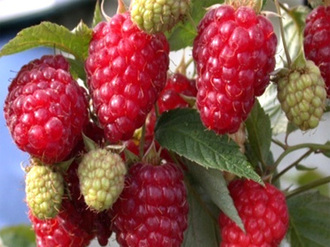 9.7 / 10 Rating Reviews This variety of raspberries fell in love with the late ripening, when only apples were left in the garden. With good care and proper fit, there are no problems with it.
|
|
Orange miracle 250 (for one year old seedling in a bag with wet moss) Repaired variety with orange berries. The bush is medium-sized, up to 1.7 m high, compact. Shoots are erect, heavily spiked, fragile and can break off under the weight of the berries. The formation of fruit branches is active and covers 2/3 of the length of the shoot. The bush forms up to 7 replacement shoots and gives a lot of growth. The berries are cone-shaped, with a slightly pointed apex, dense, even, up to 4 cm long and weighing 6 - 12 g. They have a delicate aroma and sweet taste with a slight sourness. The sugar content depends on the soil and climatic conditions of cultivation and the level of agricultural technology. The berries are well transported; when overripe, they remain on the branches. The yield from one bush reaches 3 kg, while before frost the variety manages to give 70 - 100% of the potential yield. There is a high resistance to pests and an average - to diseases. Dessert berry taste and good transportability make the variety versatile. The variety has shown itself well in the Moscow and Rostov regions, it is recommended for the Central strip, the Urals and Western Siberia. When grown in an annual culture (cutting on a stump in winter), there is no risk of freezing of the shoots. Main pluses:
Minuses:
|
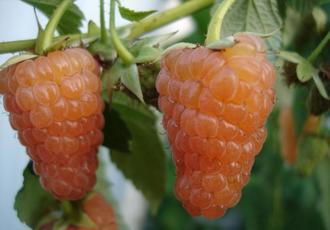 9.7 / 10 Rating Reviews The best sort of remontant raspberry for the Moscow region, in my opinion. The berry is tasty and very beautiful, ripens quickly.If you cut off the unripe berries along with the stalk, then they ripen perfectly.
|
|
Hercules 450 (for a 2 year old seedling in a container) Repaired commercial grade. The bush is 1.6 - 1.8 m high. The shoots are erect, with rigid thorns along the entire length, strong and do not require support. Lateral branching is abundant, shoots are weak (up to 3 - 4 replacement shoots). The variety tolerates thickened plantings well, does not require frequent thinning. Ruby berries, in the shape of a truncated cone, dense, weighing from 6 - 10 to 15 g, with a pronounced aroma. The taste is sweet and sour, refreshing, but in cold weather the sourness is more pronounced. The yield from one bush reaches 4 kg. Differs in high resistance to diseases (including viral) and pests, drought-resistant and winter-hardy. Waterlogging spoils the taste of the berry, making it watery. With a lack of heat and lighting during the ripening period, the berries are sour, they are good in compotes and jam. This variety of raspberries has adapted well in the Moscow region, the Middle Belt and the Urals, showing stability and unpretentiousness. In regions with cold rains in the second half of summer, it is impossible to get a high-quality berry without additional measures. Main pluses:
Minuses:
|
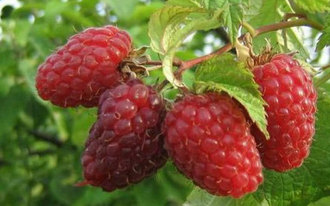 9.5 / 10 Rating Reviews For beginners, this raspberry is the easiest to care for in comparison with other remontant varieties, top dressing and a well-chosen site, it is possible to get delicious berries.
|
|
Firebird 220 (for one year old seedling in a bag with wet moss) Repaired grade for small areas. Gardeners appreciate it for its excellent taste. In terms of yield, transportability and size it loses to other commercial varieties. More often grown for personal use. The bushes are compact, up to 2 m high, forming 5 - 8 replacement shoots. Shoots are covered with soft and thin thorns, to a lesser extent on the upper part. A garter to the trellis is required. Bright red berries of a conical shape with a blunt apex, glossy, drupes are large, dense, weighing 4 - 6 g. The yield per bush is 2 - 2.5 kg. Ripe berry does not crumble. If the berries are picked regularly, avoiding overripening, then the harvest is well transported. This raspberry shows good results in the southern regions, but due to insufficient heat resistance it needs mulching and shading. In the northern regions, it manages to realize only 70% of the potential yield. Main pluses:
Minuses:
|
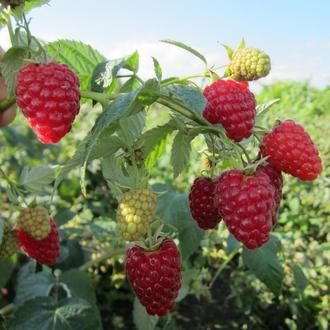 9.5 / 10 Rating Reviews An excellent dessert berry, it does not prick strongly, so the collection of berries is without negative. The care is the same as for other remontant raspberries.
|
The best classic raspberries
|
Kuzmin's news 250 (for one year old seedling in a bag with wet moss) An old classic mid-season raspberry variety that does not lose its popularity. Grown for fresh consumption and processing, not suitable for commercial purposes. The bushes are tall, from 2 to 2.5 m, erect, slightly spreading, they form few root suckers. Gives few replacement shoots. Shoots are arched, drooping. Thorns are long and thin (shorter and thicker towards the apex), cover all shoots, but their number is average. The berries are oblong, dyed red, with an average weight of 2 - 5 g, with a weak aroma. The taste is excellent, but the berries are not suitable for transportation and storage. When ripe, they are easily separated from the stalk, but do not crumble when overripe. On average, 1.5 - 2 kg can be harvested from one bush. In favorable years, repeated fruiting is possible on young shoots. The variety is not picky about soil types and care, but has a low drought tolerance.In the absence of watering, the beginning of fruiting is delayed by 2 - 3 weeks. Poorly tolerates drafts and is susceptible to viral diseases. In general, the variety is characterized as the most hardy and is recommended for "lazy" and inexperienced gardeners. It is grown in all regions of Russia, but is of particular value for the Central belt, the Urals and Western Siberia. Main pluses:
Minuses:
|
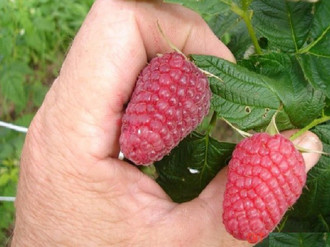 9.5 / 10 Rating Reviews The best raspberry variety for Siberia, for fresh consumption. I have 2 bushes planted especially for children. The overgrowth does not torment, I also don’t fiddle with shelter.
|
|
Yellow giant 300 (for one year old seedling in a bag with wet moss) A classic variety of early ripening yellow raspberries. The bush is powerful, 2 - 2.3 m high. 8 - 10 replacement shoots are formed, but the bush remains compact and does not fall apart. Young shoots without thorns, on old ones - in small numbers. It is prone to strong branching of fruit branches: up to 4 - 5 orders of magnitude. Intensive development of root shoots. The main fruiting is on last year's shoots, but under favorable conditions, a second wave of fruiting is possible at the tops of the young growth. Amber-yellow years are broadly conical with a blunt apex, up to 4 cm long and weighing 8 - 10 g. The yield from one bush is more than 4 kg. Due to poor transportability, they are used only for personal use. In the middle lane, it shows insufficient winter hardiness and requires additional protection. Shoots are flexible and bend easily for winter shelter. Main pluses:
Minuses:
|
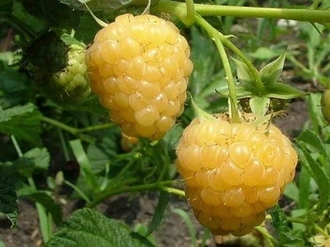 9.5 / 10 Rating Reviews I keep several bushes of this raspberry as a treat. The variety is appreciated for its excellent taste and beautiful berry. Not suitable for sale, processing and freezing.
|
|
Patricia 200 (for one year old seedling in a bag with wet moss) A classic variety of large-fruited raspberries. Spreading bush, 1.5 - 1.8 m high, annually gives 6 - 10 replacement shoots. Forms a lot of root growth, which should be removed in a timely manner. A garter to the trellis is required. Shoots of the first year without thorns. At the end of the season, formative pruning of the shoots is required. Fruiting begins in mid-June and lasts until mid-August. The berries are bright red, cylindrical or irregular in shape, with a velvety bloom, with an average weight of 5 - 6 g (up to 10 - 12 g). Drupes are large, fit tightly. The aroma is pronounced. The average yield is 4 - 5 kg per bush, but it can reach 8 kg. The berries do not tolerate transportation well and are not intended for long-term storage. The variety does not tolerate waterlogging. Recommended for the Central region of Russia, but successfully grown in the Urals. Main pluses:
Minuses:
|
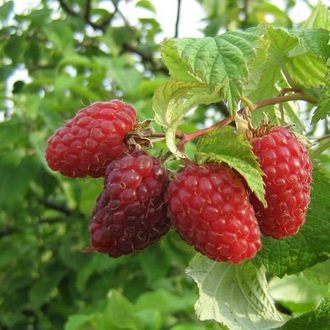 9.4 / 10 Rating Reviews Berries with a very delicate pulp, ideally: pick and eat immediately. With the harvest, raspberries cannot be postponed - overripe berries become moldy and crumble.
|
The best standard raspberry varieties
|
Tarusa 300 (for one year old seedling in a bag with wet moss) Standard raspberry with late ripening. In one season, a branchy tree grows up to 1.8 m high, with thick shoots on a trunk. Shoots are elastic and do not need a garter, there are no thorns. The variety branches beautifully and does not need special labor-intensive pruning. Gives 3 - 4 replacement shoots annually. No more than 10 shoots are left in the bush. Berries are claret-red, sweet and sour, conical or irregular, up to 10 - 15 g, dense and transportable, have a pronounced aroma and are good for processing. Small seeds are almost not felt. Productivity is high: up to 4 kg per bush. Despite the high declared winter hardiness, freezing is observed in the windy area in snowless winters. Grown from the Moscow region to the Urals. In rainy summers, the berries are watery and sour. The taste is strongly influenced by grooming and feeding. Main pluses:
Minuses:
|
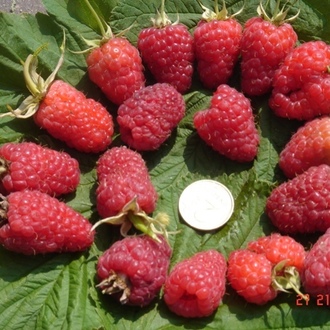 9.7 / 10 Rating Reviews The shoots at Tarusa are powerful, but under the weight of the crop they still sag and can break, so I use a trellis. Good yield, we use it for making jam and jam - it turns out very fragrant.
|
|
Monomakh's hat 270 (for a one year old seedling with a bag of wet moss) Standard raspberry variety with remontant fruiting. The bush is up to 1.5 m high, forms up to 5 powerful branched shoots with drooping tops. The lower part of the shoots has hard thorns. Due to the weak formation of shoots, cuttings are more often used for reproduction. Berries of juicy red color, weighing from 7 to 20 g, pyramidal with a blunt top, sweet with a slight sourness and bright aroma, leveled and mouth-watering. When assembled, they do not fall apart, are suitable for storage and transportation. An average of 4 - 5 kg is harvested from one bush. Reacts painfully to interruptions in watering, tying small berries. The variety has an average winter hardiness. In the northern regions, under conditions of early frosts due to late ripening and extended fruiting, it realizes only 50% of the potential yield. This raspberry variety is good for the southern regions. In the middle lane, it is grown in an annual crop, when in autumn the shoots are cut to ground level. Main pluses:
Minuses:
|
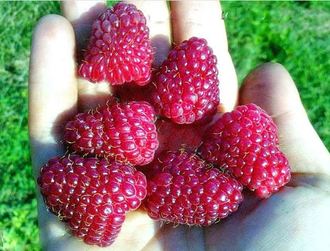 9.3 / 10 Rating Reviews Dessert-tasting berries, neat, fruitful bushes. Raspberries require attention, but this is for all large-fruited varieties.
|
Studying the varietal diversity in the catalogs of online stores or nurseries, one should not forget about acclimatization and varietal testing in new climatic conditions for the variety. If the raspberry variety seems attractive to you and has positive reviews in other regions, then first you should buy 1 - 2 bushes, provide them with better conditions and conduct your own assessment. Taste, strength of growth, ripening period are largely determined by the growing conditions: climatic zone and agricultural technology.
Have a nice harvest!
Attention! The reliability of the information and the results of the ratings is subjective and does not constitute advertising.
Gardeners began to engage in the selection of wild-growing raspberries more than four centuries ago. And since then we have received many of the most incredible varieties of this berry. Today there are large-fruited, remontant, high-yielding raspberries of different colors and ripening periods ...
It is precisely on the last characteristic that we will dwell, consider the most successful and interesting varieties of raspberries among its early ripening representatives. Yes, yes, if you didn't know, you can feast on this fragrant berry from your own plot already at the beginning of summer! You just need to know what kind of raspberries of domestic or foreign selection to plant in your country house - each variety has both its advantages and some disadvantages. The choice, as always, is yours.
The best early raspberries
Early ripening varieties of raspberries, depending on the territorial location of your region, can begin to bear fruit as early as the end of May. However, some varieties take so long to produce berries that inexperienced gardeners may mistakenly classify them as remontant.The berries of most representatives of this group have very high commercial qualities. However, they also have common disadvantages. For example, most of the early raspberry varieties are distinguished by a slightly reduced fruiting volume compared to their "later" counterparts, which does not prevent them from being the favorites of private gardeners, but makes them unsuitable for cultivation for the purpose of marketing or industrial production.
We present to you our TOP-7 of the best varieties of early raspberries.
Malina News Kuzmina
This early ripe raspberry belongs to the varieties of the oldest domestic selection - it was bred, you will not believe it - back in the 1880s in the Nizhny Novgorod region! And until now Novost Kuzmina is one of the most widespread and beloved varieties in our country.
| Malina News Kuzmina | |
| a brief description of: forms an erect semi-spreading bush up to 2-2.5 m high with an average number of weakly spiked shoots, covered with a grayish waxy bloom. The flowers are large and white. Leaves are medium in size, dark green, slightly wrinkled, with soft, few miniature thorns on the underside. The variety has a high level of self-fertility. Fruiting - about 50 days. Productivity - up to 1.5 kg per bush (50-60 kg / ha). | |
| Description of fruits: berries weighing 2-4 g, raspberry, matte, obtuse-conical, with long stalks, with a weak aroma. The taste is excellent - "classic raspberry", sweet with a sour-sweet aftertaste. The pulp is juicy, well separated from the stalk. | |
| Ripening period: mid-early. In the middle lane, it begins to actively bear fruit in mid-June. | |
| Growing features: the variety is very unpretentious and hardy, extremely winter-hardy. This raspberry is not picky about soils, although it prefers fertile sunny areas, protected from cold drafts. Pinching of young shoots and a garter are necessary. The main requirement for care is regular abundant watering, without which the berry becomes sharply smaller. The variety is poorly tolerant to fungal and viral infections, to pests, however, the berries have time to ripen even with a noticeable damage to the bushes. The berry is poorly transportable, it also cannot boast of high keeping quality. | |
Raspberry Meteor
This domestic variety was bred in the Bryansk region on the basis of Kuzmin's News. He did not inherit the large size of the "parent", but can boast of the same wonderful taste and an earlier ripening period.
| Raspberry Meteor | |
| a brief description of: forms an erect, slightly spreading bush up to 2 m high with an average number of weakly spiked shoots, covered with a weak waxy bloom, drooping tops in adulthood. The variety has a good level of self-fertility. Fruiting is amicable, lasts about 15 days. Productivity - up to 2 kg per bush (50-80 kg / ha). | |
| Description of fruits: berries weighing 2-3.5 g, ruby, hemispherical, with a pronounced aroma. Dessert taste, sweet with a slight sourness. The pulp is juicy, but firm enough. | |
| Ripening period: early. In the middle lane, it begins to actively bear fruit in early June. | |
| Growing features: the variety is unpretentious and very winter-hardy; The raspberry plant is resistant to most fungal diseases and the raspberry mite, but it is affected by spider mites, shoot gall midges, and purple spot. Not resistant to overgrowth. Can do without a garter. In favorable weather, it forms an autumn harvest on the tops of annual shoots. The berry is well transportable. | |
Raspberry Runaway
This variety of early raspberries, which is very popular among our gardeners, was bred at the same Kokinsky support point of VSTISP in the Bryansk region, and by the same famous breeder Kazakov, who gave a lot of magnificent varieties of raspberries.
| Raspberry Runaway | |
| a brief description of: forms a medium-sized, erect, weakly spreading bush up to 2 m high, with an average number of upright shoots almost without thorns. Leaves are medium in size, green, wrinkled, without pubescence.Fruiting - about 50 days. Productivity up to 2 kg per bush (50-75 kg / ha). | |
| Description of fruits: berries weighing 2-3 g, golden apricot color, round-conical shape, with a delicate aroma. Harmonious sweet and sour taste. The pulp is tender. | |
| Ripening period: mid-early. In the middle lane, it begins to actively bear fruit at the end of June. | |
| Growing features: the variety is moderately resistant to heat and drought, but extremely winter-hardy. It is tolerant to the main fungal diseases. Sensitive to spider mites, raspberry gnats and mycoplasma overgrowth. Prefers well-lit areas, sheltered from the wind. The berry is poorly transportable. | |
Raspberry Scarlet Sails
And again, the product of the selection of the Kokinsky stronghold is unpretentious, winter-hardy with a wonderful taste of berries.
| Raspberry Scarlet Sails | |
| a brief description of: forms a powerful upright semi-spreading shrub about 2.2 m high with a large number of upright, weakly spiked shoots, drooping tops in an adult state and prone to branching. The leaves are large, green, wrinkled, with a light underside. In autumn, at the top of the bush, they turn bright purple. Productivity up to 1.7 kg per bush (50-65 kg / ha). | |
| Description of fruits: berries weighing up to 2.7 g, ruby color, rounded-conical shape, with a weak aroma. The taste is classic, balanced, sweet with a sour-sweet aftertaste. The pulp is tender, with small, very soft bones. | |
| Ripening period: early. In the middle lane, it begins to actively bear fruit in early to mid-June. | |
| Growing features: the variety is extremely winter-hardy; in severe winters, when the main bud freezes, it forms a crop due to axillary ones. It is tolerant to the main fungal and viral diseases. May be affected by raspberry and spider mites, sensitive to mycoplasma overgrowth. The berry is medium transportable. | |
Raspberry Lyashka (Laszka, Lashka, Lyachka)
And this variety of Polish raspberry selection in 2006 is distinguished not only by its early ripening period, but also by its high yield and early maturity.
| Raspberry Lyashka | |
| a brief description of: Forms an erect semi-spreading bush up to 2-2.5 m high with an average number of hard shoots covered with a brown waxy bloom and with numerous small, almost non-prickling green thorns. With age, the tops of the shoots droop. Fruiting on two-year-old shoots. Fruiting is extended, about 60 days. Productivity - up to 5 kg per bush (150-200 kg / ha). | |
| Description of fruits: berries are very large, weighing 4-10 g, dark red, matte, elongated conical shape, slightly pubescent, with a delicate aroma. Dessert taste, sweet, almost without acidity. The pulp is dense, elastic. | |
| Ripening period: mid-early. In the middle lane, it begins to actively bear fruit in mid-June. | |
| Growing features: the variety is very winter and drought resistant, resistant to most diseases. Yields can be weakened by aphids or spider mites, and uncut stems become the habitat of the raspberry beetle and the raspberry flower beetle. In winters with little snow, it requires shelter. Differs in high resistance to death of shoots and diseases that cause fruit rot. A garter of shoots is required. Failure to comply with the appropriate soil moisture leads to the occurrence of diseases that weaken fruiting. The berry is perfectly transportable. | |
Raspberry Patricia
Another variety of large-fruited early raspberries of Russian selection, this time bred in Moscow in 1986.
| Raspberry Patricia | |
|
|
a brief description of: Forms an erect semi-spreading shrub up to 1.8 m high with light brown drooping biennial stems and purple, almost thornless annual shoots with a waxy bloom. Leaves are medium in size, light green, slightly wrinkled, slightly pubescent. Peak fruiting in the third year. Fruiting - about 40 days. Productivity - about 5 kg per bush (150-200 kg / ha). |
| Description of fruits: berries are large and very large, weighing 5-12 g, bright purple, with a velvety surface, truncated-conical shape, with a bright aroma. Prone to deformation. The taste is rich, sweet. The pulp is juicy, “melting”, with large bones, well separated from the stalk. | |
| Ripening period: mid-early. In the middle lane, it begins to actively bear fruit in early to mid-June. | |
| Growing features: the variety is moderately winter-hardy, in a harsh climate in winter it requires bending the shoots under the snow. The presence of a special gene makes the cultivar immune to raspberry aphids. Also resistant to most diseases, including didimella, anthracnose, botrytis. Susceptible to late blight and requires regular control measures. Does not tolerate waterlogging of the soil. Regular pruning and tying of the shoots is required. The berry is poorly transportable. | |
Raspberry Sun
"Production" of the same Kokinsky stronghold, already familiar to us, selection of the 90s of the last century and on the basis of the same "immortal" variety Novosty Kuzmina.
| Raspberry Sun | |
| a brief description of: forms a powerful erect, slightly spreading bush up to 1.8-2 m high, which has an insufficiently high ability to shoot formation. Stems are strong, erect, with a small number of unsteady light thorns; with age, they change color from green to beige-brown or reddish with a pronounced waxy bloom. The top of an adult bush is of a drooping type, arched and characteristically curved. Productivity - about 1.5-2 kg per bush (70-80 kg / ha). | |
| Description of fruits: berries weighing 3.5-4 g, purple in color, wide blunt-conical shape, with a rich aroma. The taste is very bright, balanced, dessert, sweet with mild sourness. The pulp is tender, transparent, with small bones. | |
| Ripening period: early. In the middle lane, it begins to actively bear fruit in early to mid-June. | |
| Growing features: the variety is unpretentious, moderately winter-hardy. Resistant to anthracnose and raspberry mite, but it is affected by mycoplasma overgrowth, purple spot, shoot gall midge. The berry is quite transportable, suitable for all types of processing. | |
With the development of such a science as selection, numerous and varied varieties of raspberries have been obtained, which favorably differ from their wild forest “brothers”. Today, you may well get the first harvests of this beloved crop at the beginning of summer and enjoy them almost until frost. Try our recommended types of early maturing raspberries - you will not be disappointed! Or do you already have your early favorites? Then share your tips in the comments.
All gardeners - professionals and amateurs are attracted by the large-fruited, high-yielding raspberry varieties and certainly with a delicious aroma and taste.
In Russia, this can be achieved by observing the rules of planting and care. From the proposed material, you can get acquainted with raspberry varieties with photographs and descriptions that are distinguished by good yield, taste, winter hardiness and resistance to diseases and pests.
You need to know that the planting material is selected taking into account personal preferences, as well as the climatic conditions of a particular area.
Early raspberry varieties
There are many early types of raspberries, it is impossible and unnecessary to pay attention to each of them in one article.
Consider several varieties of frost-resistant, well-established in the middle lane. Of course, the most interesting are high-yielding, large-fruited, resistant to diseases, pests and drought.
Here are brief characteristics of early raspberry varieties with descriptions and photographs: Here are the traditional raspberry varieties - "raspberry" color. About the ripening time of yellow, black, and remontant varieties - information in the relevant sections of the article.
So:
Bryansk cascade
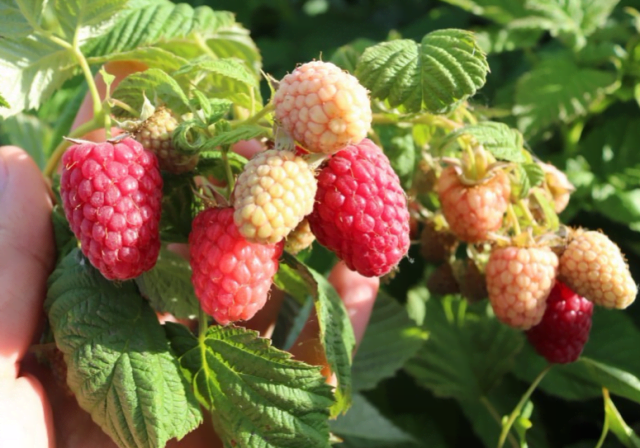
Medium spreading bushes of medium height also give berries of medium weight - up to 2.5 g of blunt-pointed rounded shape (pictured above).
The variety does not require special care, but the yield is good, with a standard planting scheme - up to 1 kilogram per 1 m2.
Balm
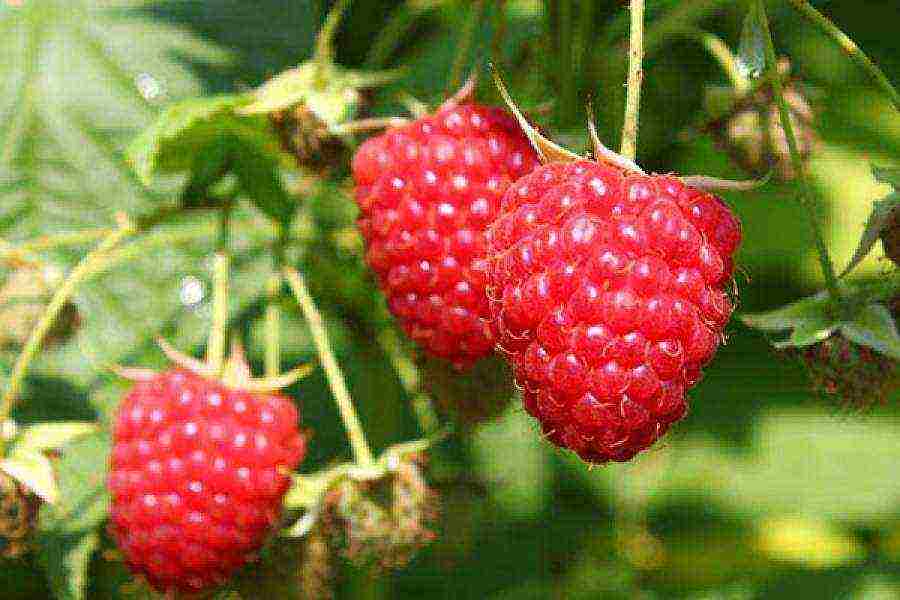
Shoots up to 2 meters high with a waxy bloom, low prickly, berries weighing 2.5-3g, dark shade. Yields a yield of 0.6-0.8 kg per 1m2. The variety is not afraid of spider mites and purple spot.
Novokitaevskaya
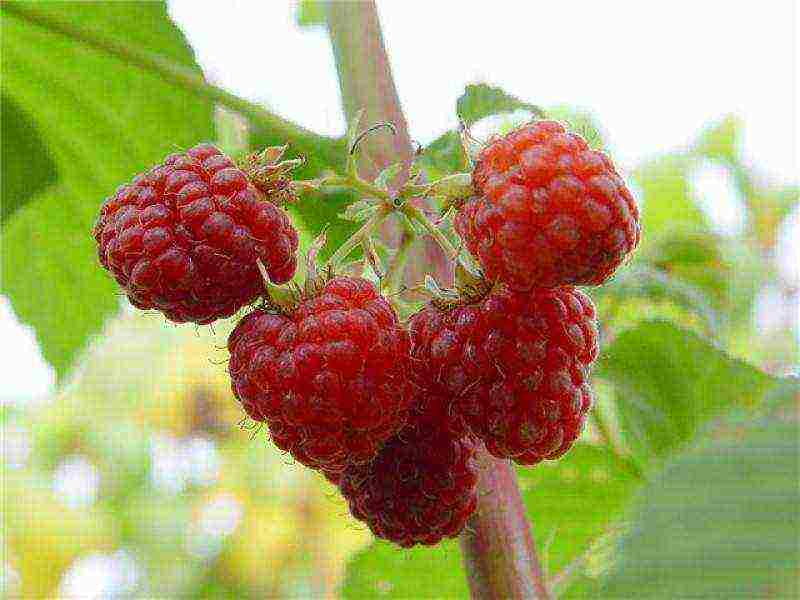
The variety was entered in the State Register in 1974, obtained by crossing the varieties Kitaevskaya and Novost Kuzmina. If you pay due attention to Novokitaevskaya raspberries on your site, then the yield can be raised up to 4 kg from one bush. Blunt-pointed berries weighing up to 2.5 g have good consumer qualities.
Meteor
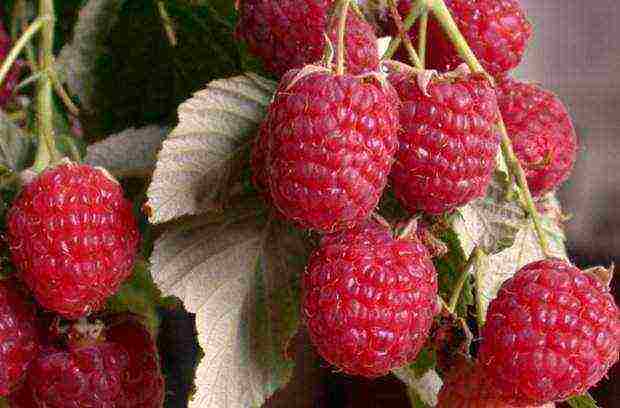
The early variety among the early ones, obtained by crossing the raspberries Kostinbrodskaya and Novost Kuzmina. Berries weighing up to 3g. Harvest from one bush - 1.5-3 kg of sweet and sour fruits. Resistant to raspberry mites and major fungal diseases, and from spider mites requires timely protection.
Mid-season varieties
Gardeners have the same wishes (or requirements) for raspberry varieties of medium ripening periods as for everyone else - high yield, frost resistance, etc.
The average ripening period of raspberries is a rather loose concept, because the same variety can be planted in different climatic conditions - this is, firstly.
Secondly, summer weather in any year can bring its own surprises, which can "shift" the ripening phase of berries according to the "usual" timing.
Thirdly, the agricultural technology used, the wishes and capabilities of the gardener - can also affect the timing of fruiting. In a word, as in the famous funny book - the rescue of drowning people, the work of the drowning people themselves.
While early varieties of raspberries usually satisfy appetite, mid-ripening berries are mostly processed into compotes and jams.
These are the following varieties that provide good yields:
Reward
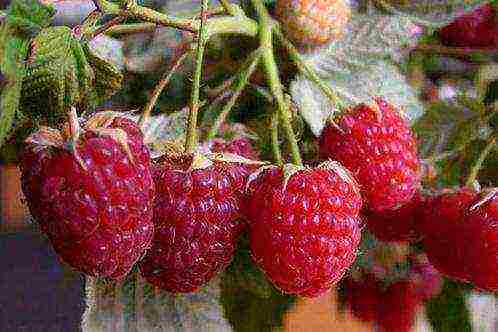
Tall bushes that do not require garters on trellises yield up to 3 kg of tasty, sweet and sour, blunt-pointed fruits weighing up to 3.5 g; The variety was obtained in the early 70s by crossing raspberries Kolkhoznitsa and Lloyd George, and is still loved by gardeners in the middle lane.
Balm
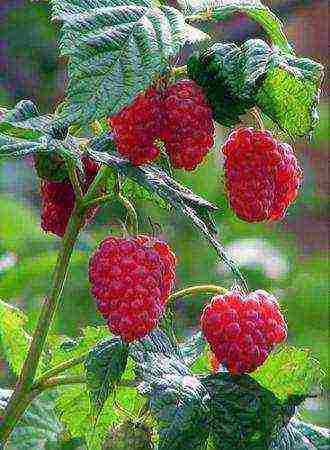
Ideal berry (2.5-2.8 g) for homemade preparations. Shoots reach a height of 1.8 m, their yield is higher than average - 2.2 kg from a bush. Derived from Newburgh and Rubin Bulgarian varieties. Good winter hardiness. The variety is included in the State Register of most Russian regions.
Zorenka Altai
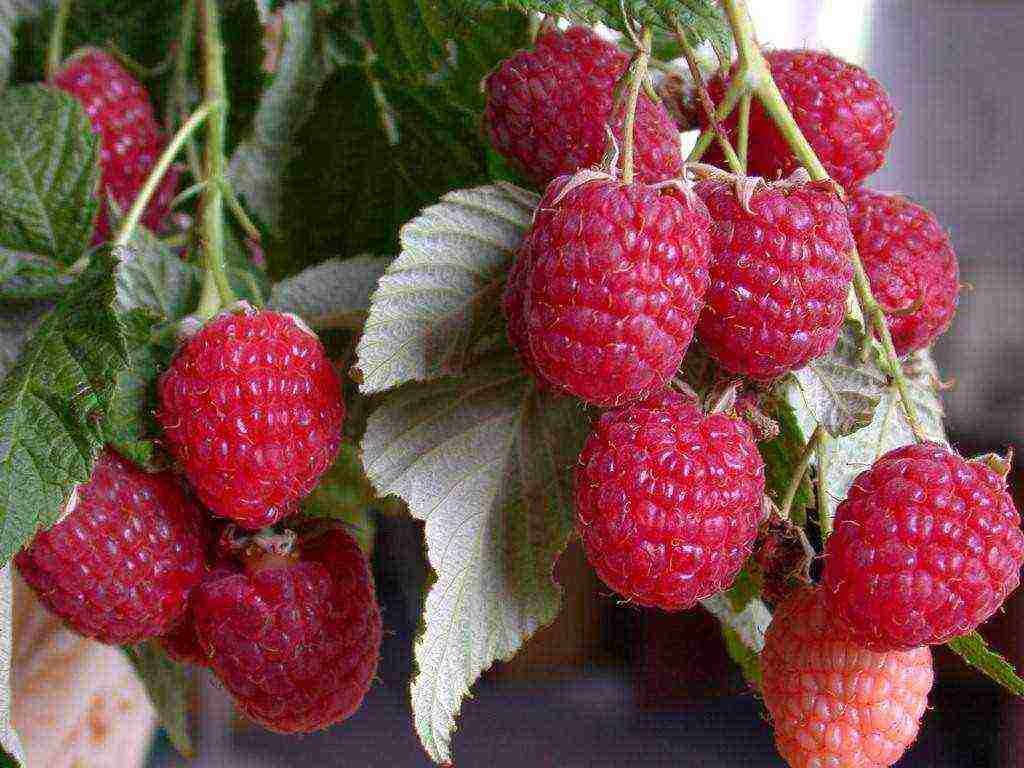
It is characterized by a sweet-sour taste of berries weighing up to 3 g. A tall, medium-spreading bush does not have a high yield. The originator of the variety is the Siberian Research Institute of Horticulture. The variety is obtained by natural pollination of wild berries and Viking raspberries.
Shy
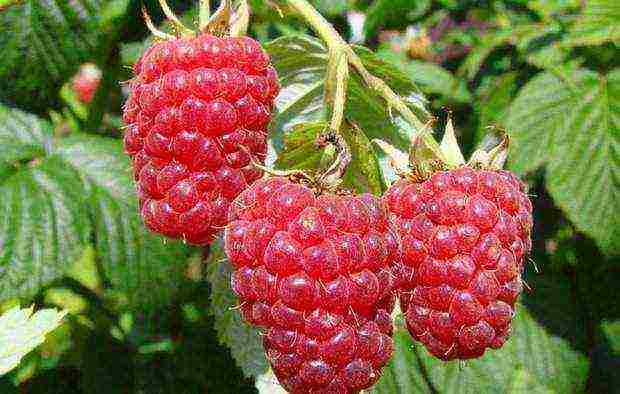
Erect shoots of low "growth" tolerate frosts well, but react painfully to drought. Conical berries, weighing up to 3 g, dark shade, with a weak aroma, yield 2.2 kg per bush. The "parents" of the Shy ones are the Ottawa and Rubin varieties.
Giant
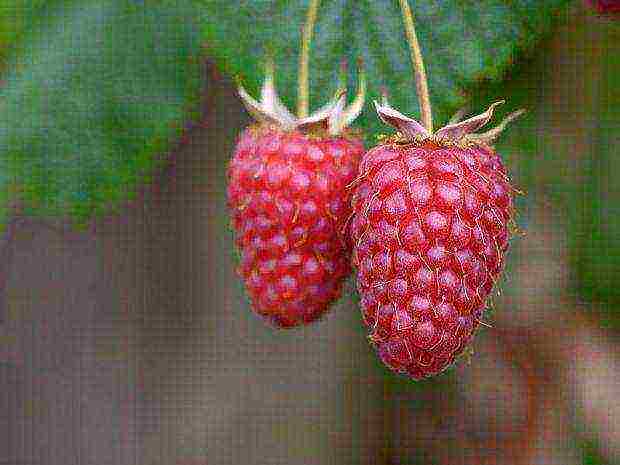
The name of the variety speaks of large fruits (up to 18 g) and high yield - 5-6 kg of sweet and sour, oblong, dense berries can be removed from the bush. The variety is also called the Pride of Russia, and it justifies itself. In the northern region, it is recommended to cover the shoots for the winter.
Late ripening varieties
Late varieties are good because in a peculiar way they remind of warm summer days.
These varieties completely replace remontant ones, if the gardener does not have an attachment to this type:
Brigantine
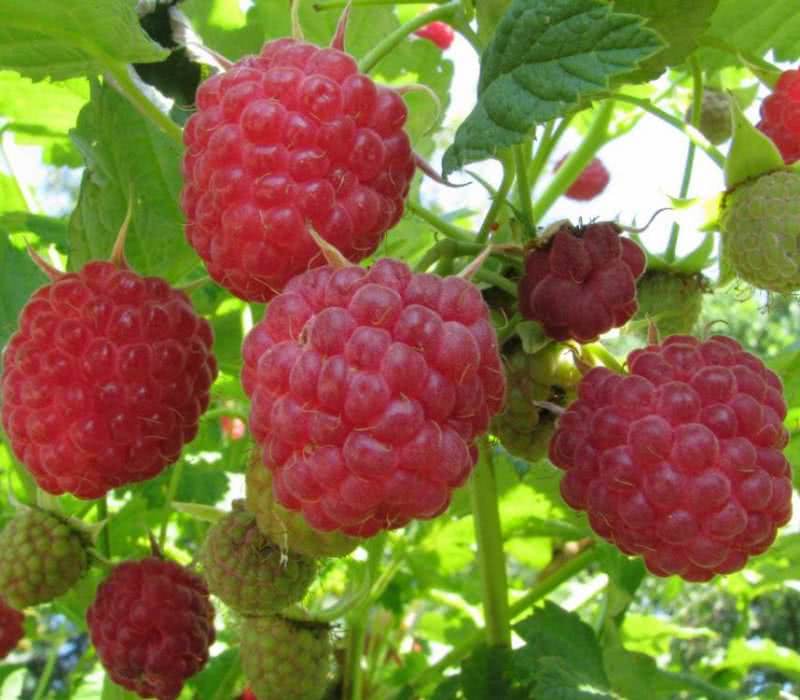
It tolerates severe frosts with sufficient snow cover. Good yield for home cultivation - 2.2 kg per plant. The berries are round, slightly conical, weighing up to 3 g, suitable for transportation. The variety was bred by crossing the Sayana and Ottawa varieties.
Mirage
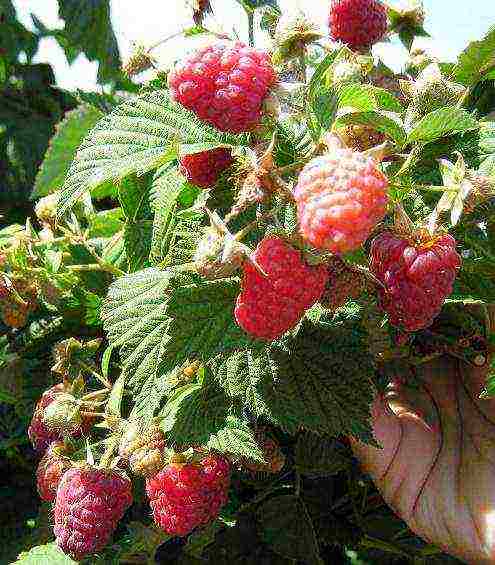
A high-yielding variety, gives 4 kg of berries weighing 5-6 g per bush, tall (up to 2.5 m), medium winter hardy, the stems with a waxy bloom are covered with thorns. High transportability of fruits.
Companion
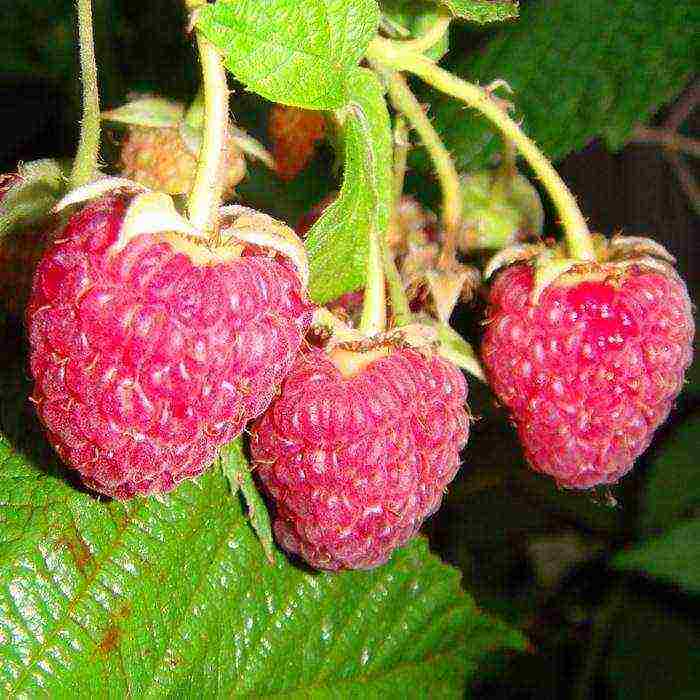
In the fall, the attentive gardener will give up to 2 kg of dark, blunt-conical, vitamin C-rich berries weighing 2.5 - 3.0 g from one bush. The dense texture of the fruit makes them transportable. There is no wax coating on the shoots, but there are enough thorns.
Repaired plants
The advantage of the remontant type of raspberry is that it is less susceptible to diseases and pests than summer raspberries, and does not require constant chemical treatments. Repaired raspberry varieties have an increased need for sunlight and warm fertile soil. Well-lit areas are desirable for planting a remontant variety; a slight shade can significantly reduce the yield.
The success of growing remontant raspberries can be indicated by the following rule - the more heat and sun, the better. This is especially true for the Leningrad region - a territory with a transitional continental to maritime climate.
To plant raspberries, you need to select places protected by buildings, bushes, trees from cold northern winds.
Before laying a raspberry tree, it will not be superfluous to conduct a competent analysis of the soil in a specific area.
In the North-West of Russia, high-yielding remontant varieties have proven themselves well:
Unattainable
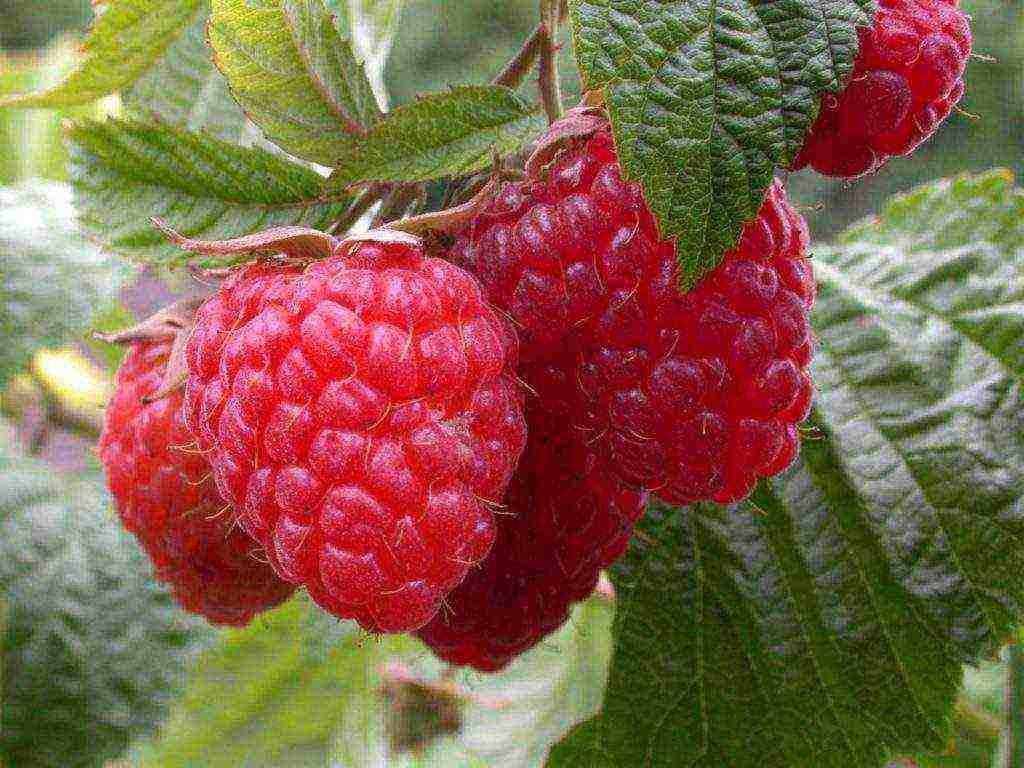
The berries ripen before the start of frost - in mid-September. Their weight is from 3 to 6 g, dark red, uniform, medium density. Fruits with a delicate "raspberry" aroma, few seeds, perfectly removable from the fruit-bearing, transportable. The average yield per bush is 2.5-3 kg, but it can be doubled with careful care. Ripening - from early August to mid-September.
Kalashnik
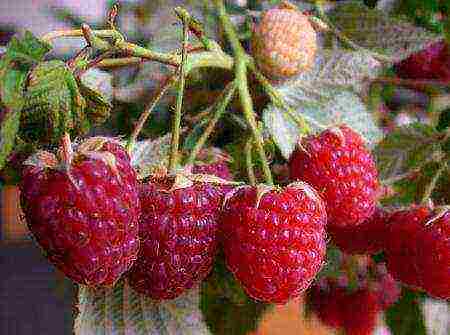
The characteristics of the variety are almost the same as the Inaccessible Raspberry. Plants up to 2 meters high, powerful, spreading, form up to 12 replacement shoots and up to 10 root suckers. Productivity - more than 2 kg of berries weighing 3.5 g;
The yellow Orange miracle also belongs to the remontant varieties, which will be mentioned below.
Yellow raspberry
In the middle lane, the berry is not as popular as the traditional red one, although the cultivation methods are the same as the agricultural techniques of the scarlet's relative. Many gardeners argue that the taste of yellow raspberries is even higher, but as they say: to taste and color. ... This type of raspberry is used in landscape design - the bushes lend themselves well to molding and grow "in moderation."
Advantages:
- Diet product.
- Useful for people with allergies.
- A good combination of sugars and acids.
- Blanks from yellow raspberries are obtained with excellent color.
- Yellow berry varieties tolerate cold weather better.
- This species does not ripen at the same time - the period of fresh consumption is rather long.
There are also disadvantages - low transportability, unsuitability for winemaking and freezing for long-term storage.
Gardeners unanimously call the best varieties of yellow raspberries of the middle lane:
Yellow giant
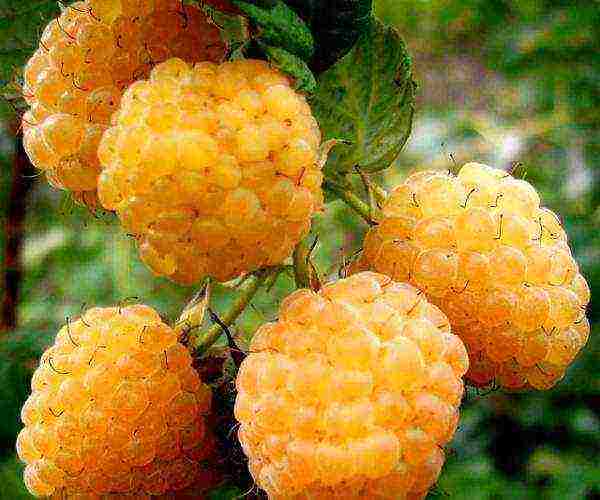
Fruits weighing up to 3.5 g, high-yielding variety (up to 10 kg per bush), disease-resistant, slightly frost-resistant. Shoots grow up to 2.5 m, in winter they need shelter under the snow.
Orange miracle
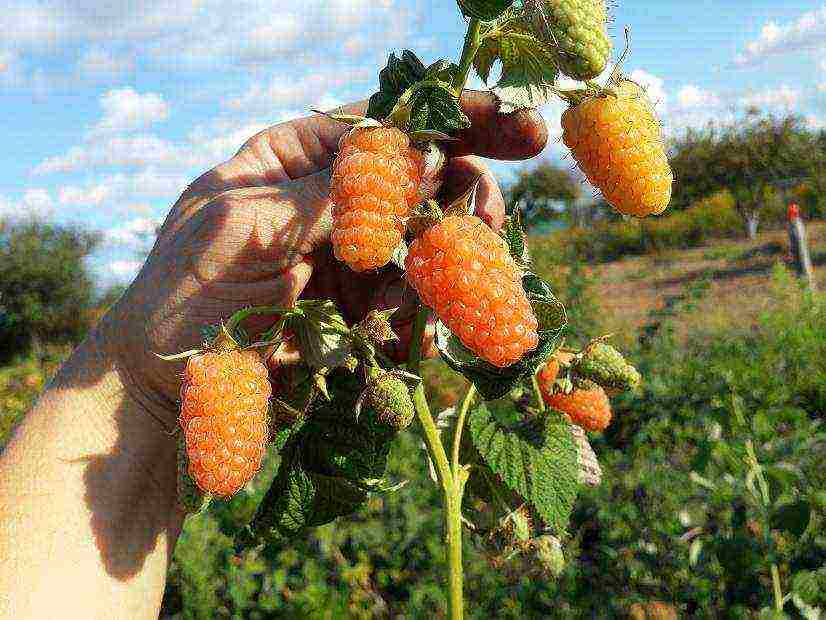
The name of the remontant variety is true. Long and dense, weighing up to 6g, berries are perfectly transported, from one small bush with many thorns, more than 2 kilograms of berries are removed. It is recommended to tie the plant up.
Runaway
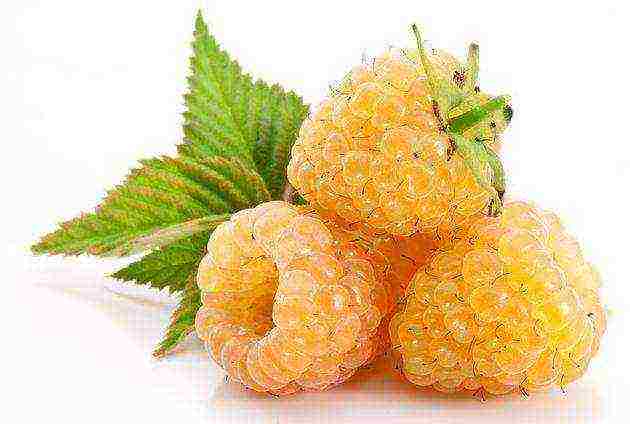
Medium height, up to 2 meters, slightly spreading bush, straight shoots, almost no thorns. Berries of apricot color, weighing up to 3 g, have a delicate aroma and taste. The yield of the variety is 2.5 kg from one plant. The disadvantage is poor transportability.
Golden autumn
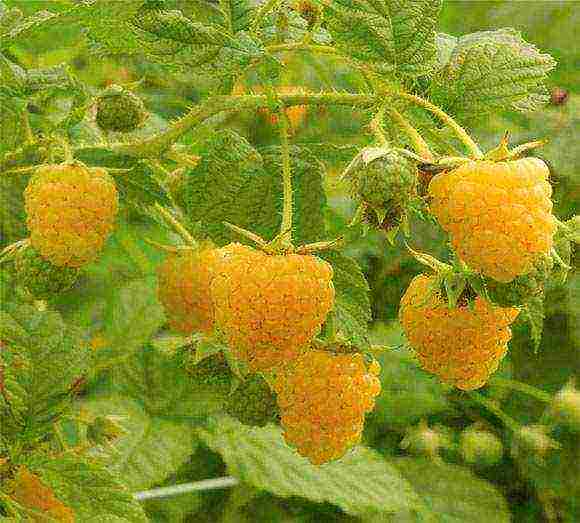
Repaired large-fruited (up to 7g), beautifully shaped, dense, with a delicate raspberry aroma. The name "Golden Autumn"? In the Leningrad region, the autumn harvest from a bush is 2.5-3 kg.
Black varieties
This type of raspberry is less common in the Middle lane due to its dubious frost resistance.However, experienced gardeners claim that by paying a little more attention to black raspberries, they will reward them with a bountiful harvest, much more significant than traditional varieties.
In appearance and description, the berry is similar to a blackberry. It is easy to check which plant it belongs to. If it comes off with a receptacle - a blackberry. The receptacle remained on the bush - raspberries.
Black raspberry bushes are decorative, they are strewn with berries of red, pink, black color during ripening, they serve as an excellent decoration of a garden plot or a flower bed.
Northwest growers prefer the American-bred Cumberland, which looks little different from other black varieties. Its peculiarity is its ability to reproduce vegetatively.
Other recognized middle lane varieties are:
Ember
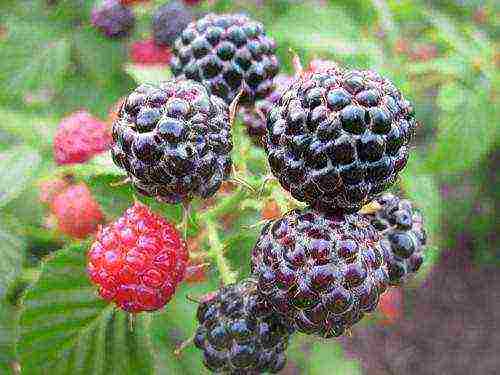
Early, with firm and sweet pulp, high-yielding, berries weighing 2 g. It tolerates frost well, is not afraid of diseases and insects. Productivity in the range of 1.5 - 2.0 kg per plant;
Airlie Cumberland
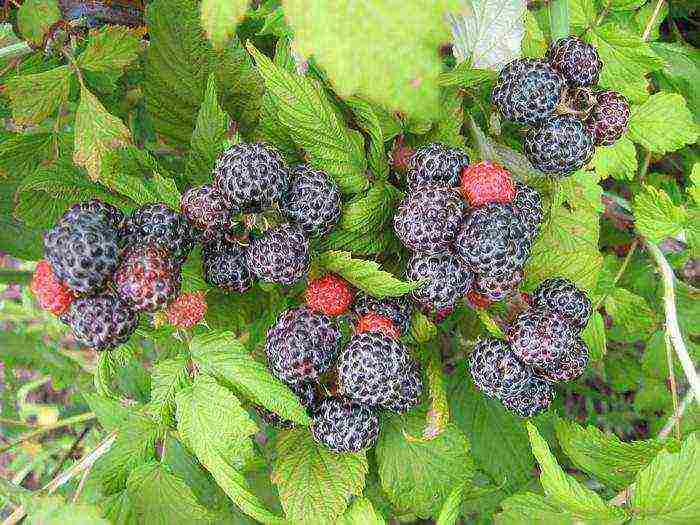
Early maturing, similar to Cumberland in many ways. Berries are black, weighing 1.6 g of a sugary sweet taste, they are not pecked by birds. The yield is high;
Bristol
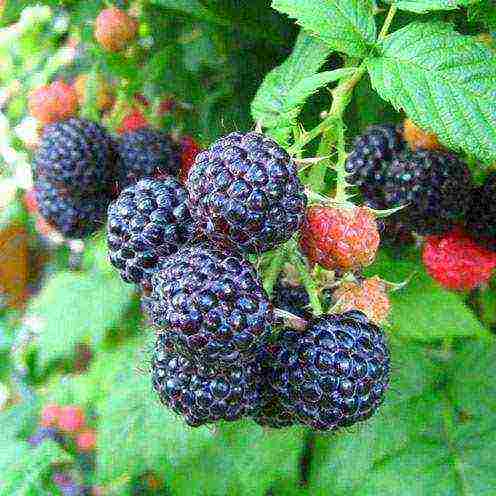
A late variety of black raspberries, considered one of the best varieties, large-fruited, sweet berries, recognized by our gardeners as high-yielding. The disadvantage is that it does not tolerate winter cold.


